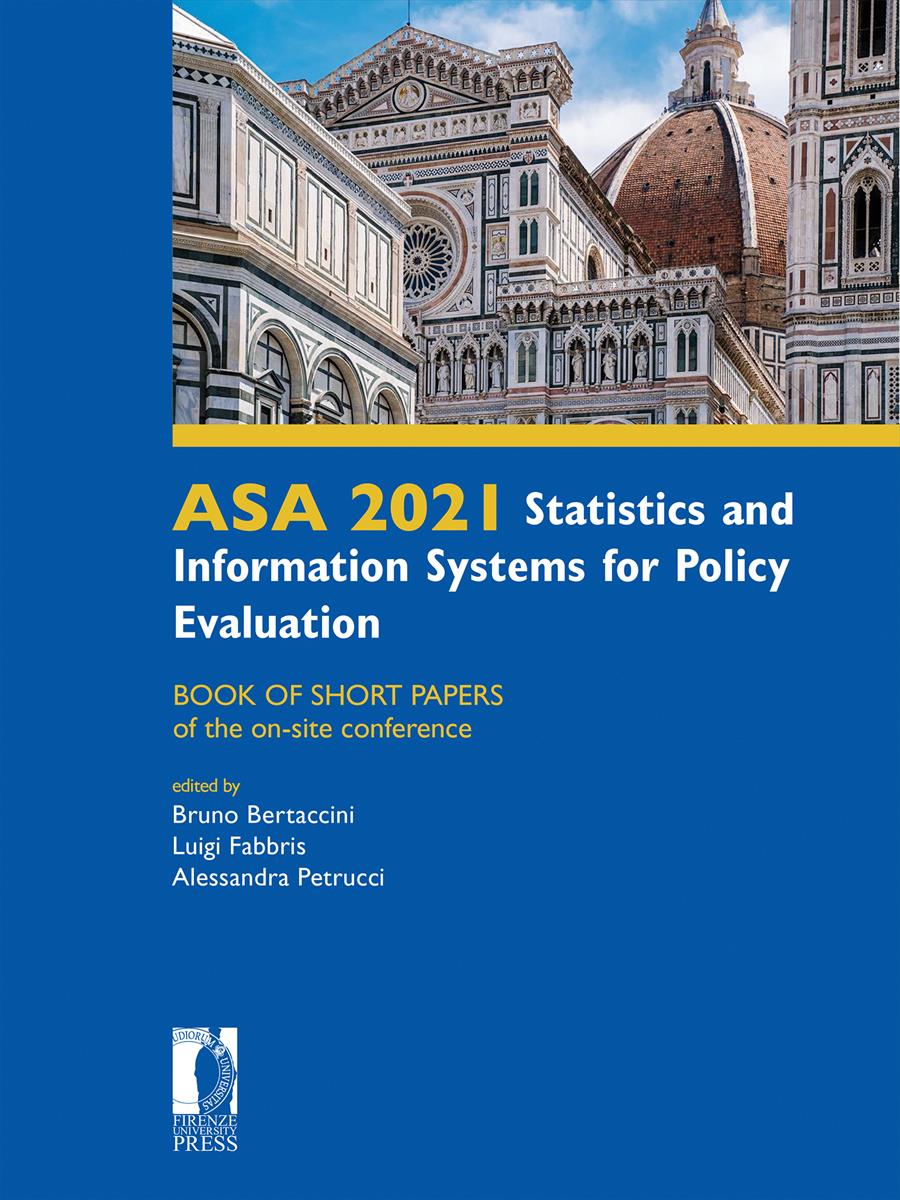- ASA 2021 Statistics and Information Systems for Policy Evaluation
- Edited by Bruno Bertaccini, Luigi Fabbris, Alessandra Petrucci
Assessment of visitors’ perceptions in protected areas through a model-based clustering
- Annalina Sarra
- Adelia Evangelista
- Tonio Di Battista
- © 2021 Author(s) |
- CC BY 4.0
- DOI: 10.36253/978-88-5518-461-8.46
Protected areas are well-defined geographical spaces that, in view of their recognized, natural, ecological or cultural values, receive protection. They have the twofold mandate of protection of natural resources and providing a space for nature-based tourism activities. In the last years, the nature-based tourism is experiencing positive and sustainable growth worldwide. Understanding the value attached by visitors to their destination and know their assessment on various activities in which they are engaged during their stay is a key element in shaping tourist’s satisfaction. Objective of this research was to identify the profiles of visitors to tourist destinations within Natural Park of Majella (Abruzzo region, Italy) and to assess the link with their satisfaction. The data for this study were collected by means of a structured questionnaire administrated to tourists who visited the sites of the protected area during the last three summer months. A total of 150 valid questionnaires were obtained and form the base of the data analysis. Through a Bayesian model-based clustering, better known as Bayesian Profile Regression, we partition visitors into clusters, characterized by similar profiles in terms of their demographic characteristics (age, gender, education attainment), as well as, in terms of the features of their travel behaviour (accommodation, length of stay, past visitation experience). A further benefit of the followed approach lies in the ability of that Bayesian technique of simultaneously estimating the contribute of all covariates to the outcome of interest. In our context, we explore the association of detected groups with the tourists’ satisfaction. In the survey, the global quality of tourism service is segmented into single features and respondents were asked to give their level of appreciation on a five-point Likert satisfaction scale. To estimate the latent trait measured by the items and related to the overall satisfaction we followed an IRT modelling.
- Keywords:
- Bayesian Profile Regression,
- Tourists' satisfaction,
- Protected areas,
- IRT modelling,
University of Chieti-Pescara G. D'Annunzio, Italy - ORCID: 0000-0002-0974-0799
University of Chieti-Pescara G. D'Annunzio, Italy - ORCID: 0000-0002-7596-9719
University of Chieti-Pescara G. D'Annunzio, Italy - ORCID: 0000-0003-2139-7273
- Leung, Y., Marion, J., Farrell,T. (2008). Recreation ecology in sustainable tourism and ecotourism: A strengthening role, in Tourism, Recreation and Sustainability: Linking Culture and the Environment, 2nd Edition.Wallingford, UK, pp. 19–37.
- Sangpikul, A. (2018). The effects of travel experience dimensions on tourist satisfaction and destination loyalty: the case of an island destination, International Journal of Culture, Tourism and Hospitality Research, 12 (1), pp. 106–123.
- Su, L., Swanson, S. R., Chen, X. (2016). The effects of perceived service quality on repurchase intentions and subjective well-being of Chinese tourists: The mediating role of relationship quality, Tourism Management, 52, pp. 82–95.
- de Ayala, R. J. (2009). The theory and practice ofitem response theory.New York: Guilford Press.
- Samejima, F. (1969). Estimation of ability using a response pattern of graded scores, Psychometrika Monograph Supplement, 34 (17), pp. 100-114.
- Molitor, J., Papathomas, M., Jerrett, M., Richardson, S. (2010). Bayesian profile regression with an application to the national survey of children’s health, Biostatistics, 11, pp. 484–498.
- Hastie, D., Liverani, S., Azizi, L., Richardson, S., St¨ucker, I. (2013). A semi-parametric approach to estimate risk functions associated with multi-dimensional exposure profiles: application to smoking and lung cancer, BMC Medical Research Methodology, 13 (129).
- Ishwaran, H., James, L. (2001). Gibbs Sampling Methods for Stick-Breaking Priors, Journal of the American Statistical Association, 96 (453), pp. 161–173.
- R Core Team (2020). R: A Language and Environment for Statistical Computing, R Foundation for Statistical Computing, Vienna, Austria. [Online]. Available: <http://www.R-project.org/>.
- Chalmers, R. P. (2012). mirt: A Multidimensional Item Response Theory Package for the R Environment, Joournal of Statistical Software, 48 (6), pp. 1–29.
- Liverani, S., Hastie, D., Papathomas, M., Richardson, S. (2015). PReMiuM: An R Package for Profile Pegression Mixture Models Using Dirichlet Processes, Journal of Statistical Software, 64 (7), pp. 1–30.
Chapter Information
Chapter Title
Assessment of visitors’ perceptions in protected areas through a model-based clustering
Authors
Annalina Sarra, Adelia Evangelista, Tonio Di Battista
Language
English
DOI
10.36253/978-88-5518-461-8.46
Peer Reviewed
Publication Year
2021
Copyright Information
© 2021 Author(s)
Content License
Metadata License
Bibliographic Information
Book Title
ASA 2021 Statistics and Information Systems for Policy Evaluation
Book Subtitle
BOOK OF SHORT PAPERS of the on-site conference
Editors
Bruno Bertaccini, Luigi Fabbris, Alessandra Petrucci
Peer Reviewed
Publication Year
2021
Copyright Information
© 2021 Author(s)
Content License
Metadata License
Publisher Name
Firenze University Press
DOI
10.36253/978-88-5518-461-8
eISBN (pdf)
978-88-5518-461-8
eISBN (xml)
978-88-5518-462-5
Series Title
Proceedings e report
Series ISSN
2704-601X
Series E-ISSN
2704-5846
